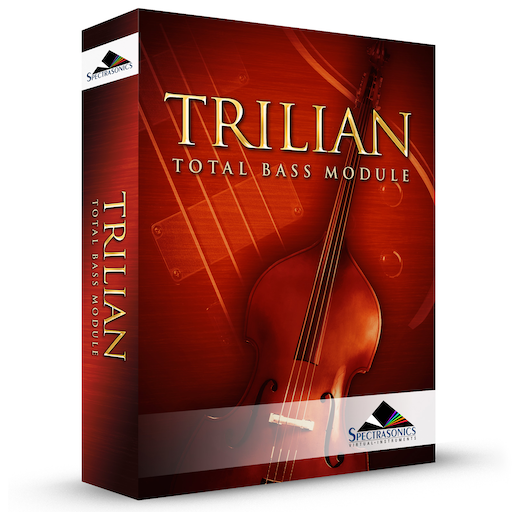
Most of Trilian Soundsources include Special Articulations. The Special Articulations are additional Soundsources loaded in the background that will be automatically triggered depending on how a passage is performed. These two Special Articulations are Legato Soundsources (samples of actual Legato performances), and Release Noise articulations.
The Special Articulations section lets you control how these are applied to the primary Soundsource.
RELEASE NOISES

Release Key Tracking
When the Release Key Tracking Button is enabled, the pitch of the Release Noises will track the keyboard. If it is disabled, the Release Noise will only play at the pitch of the root note.
TRANSITION TIME

This fader affects the transition time between Sustain Soundsource and the Release Noise Soundsource. It controls how long the note-on samples decay after the note is released, so that the transition between the sustained samples and the release noise samples is musical.
At higher settings you will hear an overlap of the sustained sample release time, and the trigger of the release noise. If the fader is all the way to the left, there will be no overlap.
Release Soundsource Menu

Release Soundsources are triggered only after a note has been released.
This menu lets you select the Soundsource used for Release Noises. You can also select “No Release Soundsource” if none is desired. Some Soundsources have multiple sets of Release Noises (e.g. a softer set), and you can even use Release Noises from other Soundsources.
NOTE: When Release Soundsources are used, the Amp Envelope Release Time affects the Release Soundsource and must be set long enough to hear the decay of the Release Noise.
RELEASE LEVEL

This level fader is used to mix the level of the Release Soundsource. Use it together with the Soundsource Mix faders to set the balance you prefer.
The biggest difference between Trilogy and Trilian release noises is that Trilian release noises are multi-sampled, meaning they are actually tuned release noises, and they include Round Robin samples, which makes the bass sound much more realistic.
When experimenting with mixing Release Noises, try mixing them louder for up-tempo tunes, and lower them for tunes with slower tempos.
If the fader is all the way to the left, no Release Soundsource will be heard. Moved all the way to the right, will make the Release Soundsource very prominent. A setting of around -3dB is usually a good starting point for a natural sound.
NOTE: Legato and Release Noise Soundsources load after the primary Soundsource samples have finished loading. If you have Release Noise Soundsources enabled, you can start playing before they have loaded, but you will hear long sustains ringing instead of the noises. This is because release times for the AMP envelope are set long to let the full Release Noises through.
Amp Release and Release Soundsources
When no Release Soundsource is selected and you let go of the key, the Amp Envelope Release time has the same musical result that you would expect on any synth. For example, all the synth bass patches in Trilian are programmed with no Release Soundsource, so they behave in this way.
If a Release Soundsource is selected, you will hear it replace the Sustain when the key is released, cross-fading at a rate that is dependent on the Transition Time setting. All the Electric and Acoustic Basses in Trilian have their Release Times set quite high so that the full decay of the noise samples can be heard.
RELEASE MODE


The MODE menu controls how much velocity and volume attenuation is applied to the Release Soundsource—depending on how long a note is sustained. Setting “Trilogy” has no velocity or volume attenuation (this is how release noises were handled in Trilogy).
LEGATO

Use Legato SS

When Legato Soundsources are available and loaded, enabling the Use Legato SS button will automatically trigger these Special Articulation samples when playing legato-phrased notes within the specified Legato Interval, providing added realism and nuance to the instrument sound.
LEGATO INTERVAL

From this menu you can select the interval within which the Legato Soundsources will be triggered.
Range: 1~ 24 semitones
Legato Rules
In Trilian Soundsources where Legato Soundsources are available, the Use Legato SS feature enables very realistic hammer-on, pull-off, and other types of performance phrasing. It allows for a natural playing style, and great sounding Legato trills!
NOTE: “Use Legato SS” is a Patch Common parameter. Changing its setting will affect all Layers in the Patch.
Enabling Use Legato SS will change the way the instrument responds to notes that are played Legato. Successive Legato notes that are played within the specified Legato Interval will behave much like a lead synth using SOLO mode. That is, the next note played will cut off the previously played note. If you sustain the cut-off note, it will sound again when you release the successive note. The key difference is that Legato Mode is polyphonic.
Notes which are played legato but are outside the specified Legato Interval will not trigger the Use Legato SS behavior.
NOTE: The Use Legato SS button only changes the behavior of the Part. In order to hear the Legato Soundsources, make sure “No Limit” is selected in the Sample Thinning – Legato menu. This will allow the Legato Soundsources to load, and can add a live, dynamic quality to the sound during performance.
Need more help with this?
Spectrasonics Customer Support



